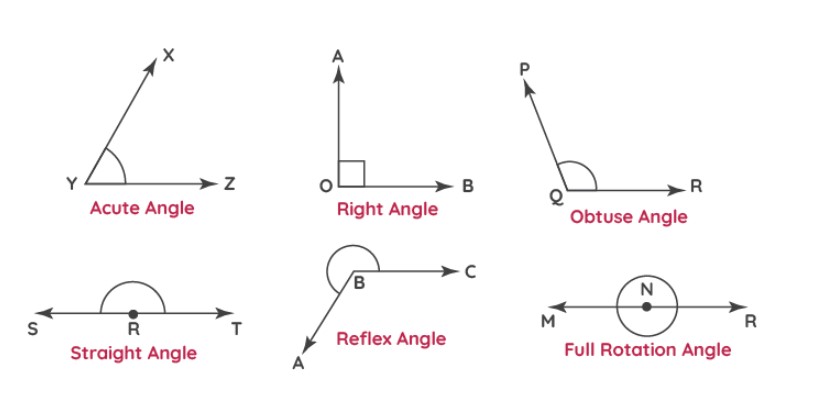Types of angles
An angle is formed when two rays or lines converge at a common point, with each angle having a unique measurement. In geometry, the various types of angles include acute angles, obtuse angles, right angles, reflex angles, and straight angles.
Also Check: Continuous Variable
Parts of Angle
An angle is composed of several key parts:
Vertex: The vertex is the common point where the two rays or lines that form the angle meet.
Sides: The sides of an angle are the two rays or line segments that extend from the vertex and form the opening of the angle.
Interior: The interior of an angle is the space within the two sides of the angle, between the vertex.
Exterior: The exterior of an angle is the space outside of the two sides of the angle, beyond the vertex.Understanding these basic parts of an angle is essential for accurately identifying, measuring, and working with different types of angles in geometry.

Types of Angles Based on Measurement
Acute Angle
An acute angle measures less than 90 degrees. It is formed when two rays intersect at a vertex, creating an angle smaller than 90°.
Examples of acute angles include 20°, 30°, 45°, and 60°. In the diagram, the angle XYZ is shown as an acute angle.
Right Angle
A right angle, measuring exactly 90°, occurs when two rays intersect to form this precise angle. The diagram illustrates that AOB is a right angle.
Obtuse Angle
An obtuse angle is one that measures more than 90 degrees but less than 180 degrees. The angle formed by rays PQ and QR in the diagram is an example of an obtuse angle.
Examples include 110°, 130°, 145°, and 165°.
Straight Angle
A straight angle measures exactly 180 degrees. It is created when two adjacent right angles combine. In the diagram, SRT is depicted as a 180° or straight angle.
Reflex Angle
A reflex angle is one that measures more than 180 degrees but less than 360 degrees. The angle ABC in the diagram is a reflex angle.
Full Rotation Angle
A full rotation angle is formed when one of the angle's arms completes a 360-degree rotation. In the diagram, MNR is a 360° angle, also known as a full rotation angle.
Frequently Asked Questions
Angles are the geometric shapes formed when two lines or rays meet at a common point called the vertex. The measure of the opening between these two lines or rays is called the angle.
The six angle pairs are: adjacent angles, vertical angles, complementary angles, supplementary angles, linear pair angles, and alternate interior angles. These pairs of angles have specific relationships between their measurements.
The 5 special angles are: acute angle (less than 90 degrees), right angle (exactly 90 degrees), obtuse angle (between 90 and 180 degrees), straight angle (exactly 180 degrees), and reflex angle (between 180 and 360 degrees).
The 7 types of angles are: acute, right, obtuse, straight, reflex, full rotation, and interior/exterior angles. These classifications are based on the angle's measurement in degrees.
The formula to calculate the measure of an angle is: Angle (in degrees) = arctan(opposite side/adjacent side). This formula is used to find the angle given the lengths of the sides of a right triangle.